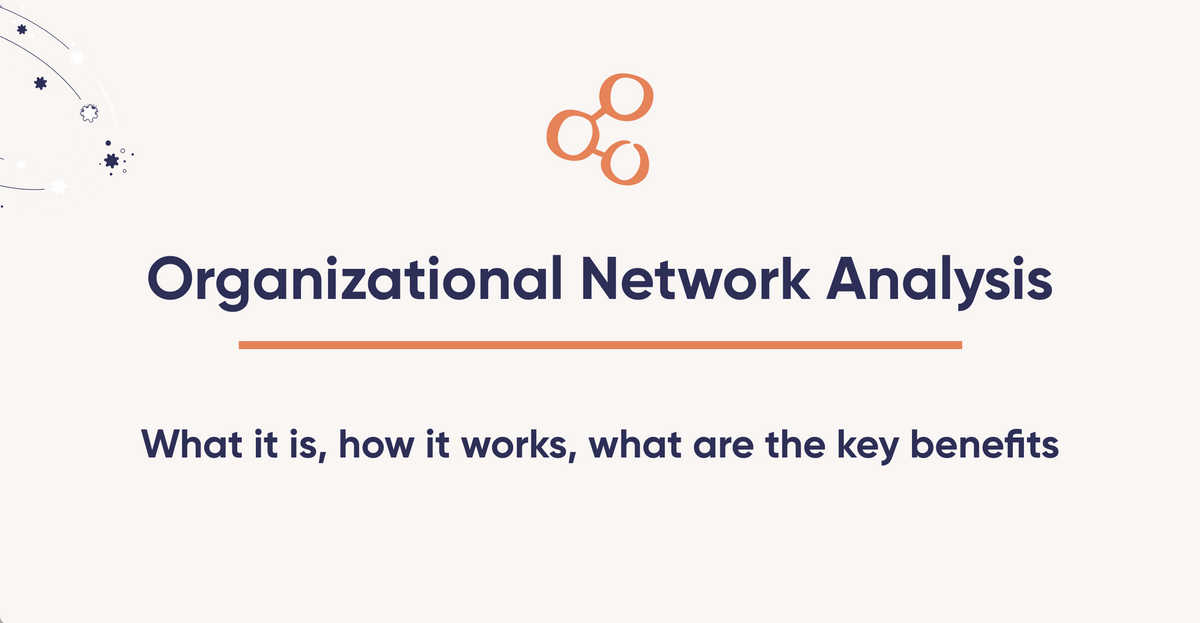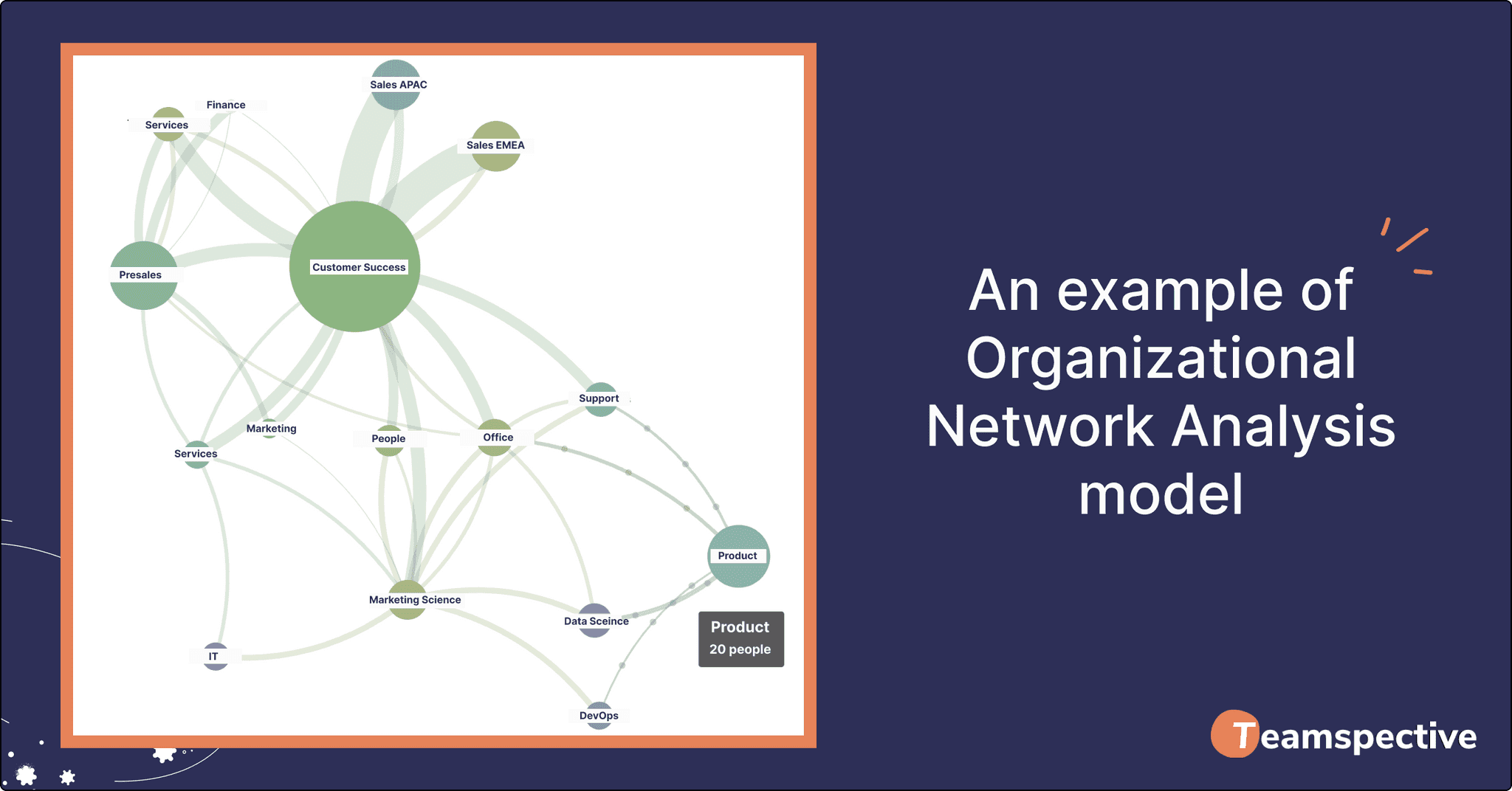In this blog post, we examine what ONA is and how it works, why it is becoming an essential tool for HR leaders, and what are the benefits of using it. We also look at some practical use cases, explain how you can get started with it, and how it ultimately helps you run a better-performing company.
Table of contents
- Introduction
- What is ONA?
- How does organizational network analysis work?
- Why is organizational network analysis an essential tool for leaders?
- What are the benefits of ONA?
- How to get started?
Introduction
Every company has an organizational structure in place, typically represented by an org chart. Based on it, every employee should have a clear idea of who reports to whom and how decision making works. But an org chart tells very little how people in your company actually work. An org chart does not help your leadership answer questions such as:
- Do team leads and other stakeholders regularly stay in touch so projects run smoothly?
- Are all your country organizations collaborating with product and engineering?
- Is a certain employee the only source of crucial information, becoming a bottleneck for other people to do their jobs?
- Are new remote employees keeping in touch with the rest of their team and others in the company so they can succeed in their roles?
- What would happen if a key person with crucial internal connections leaves the company?
Questions like these are almost impossible to answer using traditional employee engagement surveys, goal frameworks, or performance metrics. To make matters worse, they typically start surfacing only when major problems arise. Organizational Network Analysis (ONA) answers these and many more questions by uncovering how your teams and individual employees actually interact, and how information and influence flow in an organization.
What is Organizational Network Analysis?
The ultimate goal of organizational network analysis is creating a better-performing organization through better understanding of the true relationships between employees. ONA is based on social network theory. More specifically, it is an application of dynamic network analysis. ONA is a method for studying communication and networks within an organization by creating statistical and graphical models of the people, tasks, groups, knowledge and resources.
Typically, this means creating a visual representation of the connections of teams and people across the organization. With ONA, you can identify areas for improvement and support the teams that are left too detached. You can ensure that new teams fit well into the organization and existing ones are able to adapt their ways of collaborating with others.
Image: An example of an organizational network analysis model
How does organizational network analysis work?
Data sources for ONA can be divided into two groups: active and passive. Active ONA refers to the use of network surveys, i.e. asking people questions such as “Who do you collaborate with weekly?”,“Who provides you clarity on objectives and priorities?”, and “Who energizes the workplace?”. The greatest benefit of using these questions is the level of detail they provide into Expertise, Leadership and Culture – making visible the different types of relationships and influence people have to each other.
Passive ONA taps into existing data in different platforms where people collaborate, and uses that data to analyze collaboration networks in real time. These platforms include Slack, MS Teams, Google and Outlook calendars, CRM (e.g. Hubspot, Salesforce), and software development tools (Github, Linear).
When used together, passive and active ONA provide the most detailed map of an organization imaginable. If you are interested in learning more, you can find more information about top data sources for organizational network analysis and their pros and cons in a separate blog post.
Once you start collecting this data, you can start running ONA and forming visualizations. The important thing about this analysis is to keep doing it on an ongoing basis. Organizations and the relationships of people are ever-changing – doing ONA once and basing development plans on a static snapshot is extremely unlikely to produce great results in the long run.
Why is organizational network analysis an essential tool for leaders?
Today’s knowledge work is often characterized by flatter organization structures and an increasing amount of work being done fully remote or in a hybrid model. While both trends have major benefits for organizations, they are not without issues. This is where organizational network analysis comes in as it is one of the best tools to solve these and many other phenomena so companies can keep improving productivity, employee satisfaction, and retention.
Flat organizational structures
Flat organizations can be extremely efficient and productive, but there is also less leadership oversight, making it harder to evaluate how individuals are feeling, performing, and collaborating.
While lower hierarchy is usually great, it can also lead to problems being addressed only when they escalate, i.e. much later than what would have been optimal. ONA can be extremely beneficial in solving this challenge as it helps leaders to uncover issues and take action preemptively – instead of being reactive when things have already gone wrong.
Remote and hybrid work
Fully remote and hybrid work were already utilized to varying degrees by forward-thinking companies before, but they’ve now become essential for organizations competing for high-demand, highly scarce talent. While a major boost to efficiency in many cases, this explosion of remote work also introduced new issues and challenges.
With people no longer tied to the office, it becomes harder for managers and leaders to ensure that employees are successfully onboarded, and that they build and maintain the essential relationships inside the organization that allow them to succeed and, more importantly, become committed to it so that you are able to retain them. ONA can be very powerful for helping remote workers establish these connections. It allows leaders to see how new remote workers’ networks develop and helps them take corrective action if it looks like key connections are not as strong as they should be.
What are the benefits of ONA?
Better efficiency and profits
If leveraged properly, ONA ultimately allows leaders to run the business more effectively and improve the bottom line. Reducing turnover, onboarding new employees faster, or going through organizational restructuring more efficiently have very tangible monetary benefits.
Reducing attrition and increasing retention
Having a clear sense of the relationships among employees and understanding how they change, helps identify people at risk of leaving, and, more importantly, helps take pre-emptive action if parts of the organization are at risk of becoming detached. It also helps you identify key opinion leaders who might have authority inside the organization - even if they do not have an official position to match. By recognizing these individuals, you reduce the risk of losing them and potentially damaging employee morale.
Identifying silos
ONA helps you identify the parts of the organization that should work in close collaboration but are not doing so. For example, if product and commercial departments or sales and marketing do not effectively collaborate, it can end up seriously hurting your bottom line.
Reducing the negative impact of layoffs
Organizational network analysis can be extremely effective at reducing the negative impact of layoffs. By providing you an accurate picture of how teams and individuals collaborate, it also allows you to form a picture of how layoffs would affect these connections. For example, if a person in team A has crucial connections to team B and you need to let that person go, you’ll know beforehand that another person must re-establish those connections after the restructuring is complete.
More effective allocation of work and responsibilities
Understanding the connections between employees also allows leaders to allocate work more effectively. By understanding who needs support from whom, how closely certain individuals work together, and more, you’ll be able to delegate better and ensure efficient collaboration on crucial projects.
How to get started
While manual analysis of your organization might be feasible, it is extremely time consuming and almost impossible to do on a recurring basis. There can be anywhere between thousands to millions of data points and connections to take into account. This is why the easiest way to get started with organizational network analysis is to use a tailor made ONA-solution like Teamspective. Our software easily integrates with your communication tools and data sources in order to build a picture of the true connections in your organization.
If you want to learn more about what Teamspective has to offer and how we can help you build the real picture of your organization, get in touch.


